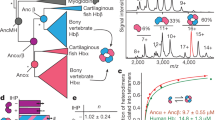Abstract
Haemoglobin (Hb) is the tetrameric protein molecule that in vertebrate blood transports oxygen from the lungs to the tissues. This function depends on four subuits in the molecule binding cooperatively so that their affinity for oxygen increases as the level of oxygenation increases. X-ray analysis has shown that deoxyhaemoglobin, which has a low oxygen affinity, and oxyhaemoglobin, which has a high oxygen affinity, differ principally in their summit or quaternary structures1, referred to as the T and R states, respectively. As it switches from the T state to the R state during oxygenation, Hb increases its oxygen affinity. However, the structural pathway between deoxy- and oxyhaemoglobin is not known, principally because there has been no accurate structural knowledge of the intermediate states. We report here the crystal structure of T state human Hb in which the α chains are oxygenated and the β subunits are oxygen-free. In this crystal the Hb appears to be in an intermediate state between the unliganded T state and the liganded R state. There is also evidence that the Hb molecule operates by loading and unloading the β haems and thus the α-oxy,β-deoxy Hb crystal may represent a physiologically important state2.
This is a preview of subscription content, access via your institution
Access options
Subscribe to this journal
Receive 51 print issues and online access
$199.00 per year
only $3.90 per issue
Buy this article
- Purchase on Springer Link
- Instant access to full article PDF
Prices may be subject to local taxes which are calculated during checkout
Similar content being viewed by others
References
Baldwin, J. & Chothia, C. J. molec. Biol. 129, 175–220 (1979).
Weber, G. Nature 300, 603–606 (1982).
Perutz, M. F. Nature 237, 495–499 (1977).
Fermi, G. J. molec. Biol. 97, 237–256 (1975).
Shaanan, B. Nature 296, 683–684 (1982).
Fermi, G. & Perutz, M. F., in Haemoglobin and Myoglobin (eds Phillips, D. C. & Richards, F. M.) (Clarendon, Oxford, 1981).
Anderson, L. J. molec. Biol. 94, 33–49 (1975).
Viggiano, G. & Ho, C. Proc. natn. Acad. Sci. U.S.A. 76, 3673–3677 (1979).
Ward, K. B., Wishner, B. C., Lattman, E. E. & Love, W. E. J. molec. Biol. 98, 161–171 (1975).
Grabowski, M. J. et al. Biochem. J. 171, 277–279 (1978).
Derewenda, Z. S., Dodson, E. J., Dodson, G. G. & Brzozowski, A. M., Acta crystallogr., A37, 407–413 (1981).
Agarwal, R. C., Acta crystallogr., A34, 791–809 (1978).
Dodson, E. J., Isaacs, N. W. & Rollett, J. R. S., Acta crystallogr. A34, 931–935 (1978).
Phillips, S. E. V. J. molec. Biol. 142, 531–554 (1980).
Jack, A. & Levitt, M. Acta crystallogr. A34, 931–935 (1978).
Author information
Authors and Affiliations
Rights and permissions
About this article
Cite this article
Brzozowski, A., Derewenda, Z., Dodson, E. et al. Bonding of molecular oxygen to T state human haemoglobin. Nature 307, 74–76 (1984). https://doi.org/10.1038/307074a0
Received:
Accepted:
Issue Date:
DOI: https://doi.org/10.1038/307074a0
This article is cited by
-
An alternative theoretical formula for hemoglobin oxygenation
European Biophysics Journal (2008)
-
Crystals of haemoglobin with the T quaternary structure bind oxygen noncooperatively with no Bohr effect
Nature (1991)
-
Structure of the liganded T state of haemoglobin identifies the origin of cooperative oxygen binding
Nature (1988)
-
Distal residues in the oxygen binding site of haemoglobin studied by protein engineering
Nature (1987)
Comments
By submitting a comment you agree to abide by our Terms and Community Guidelines. If you find something abusive or that does not comply with our terms or guidelines please flag it as inappropriate.



